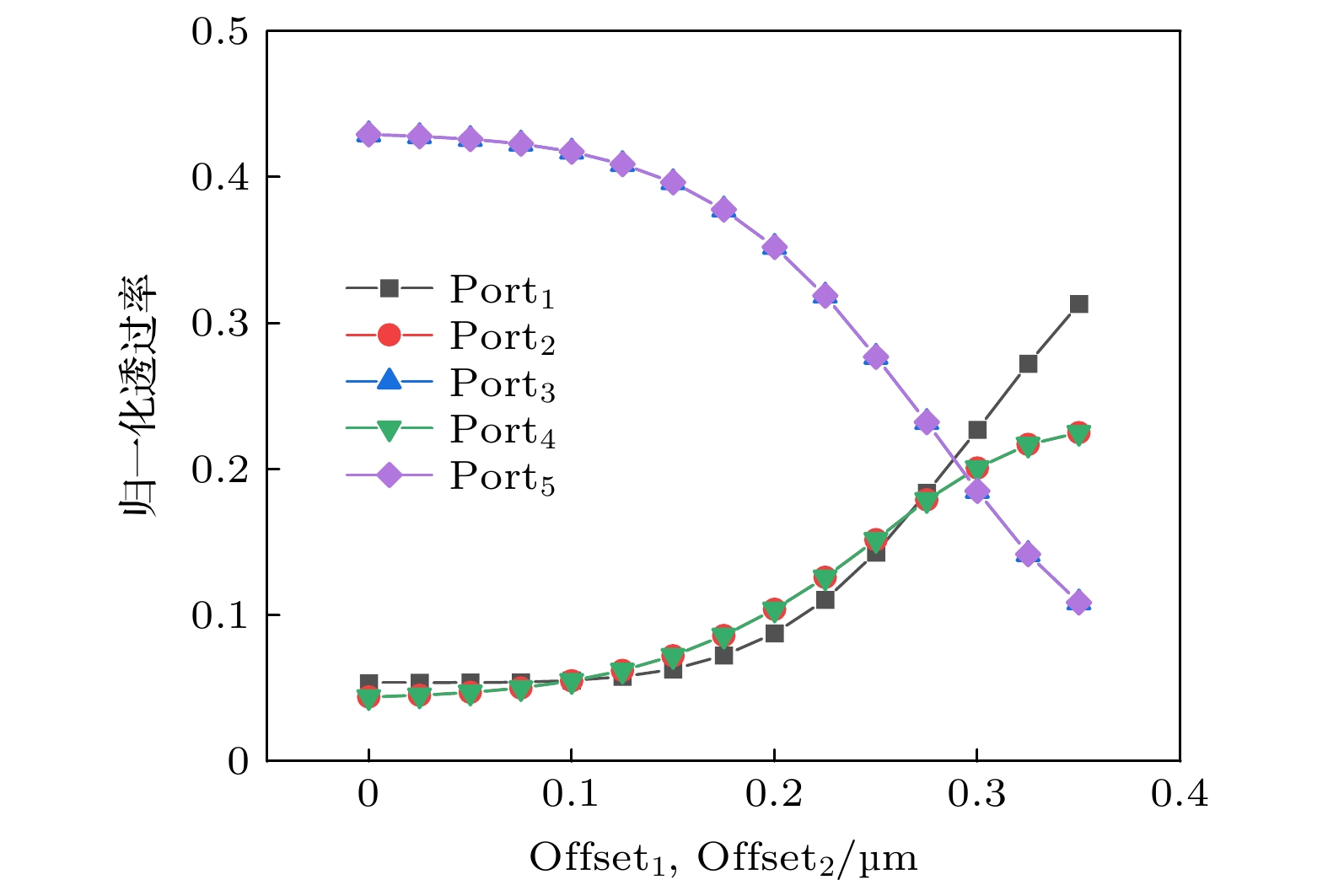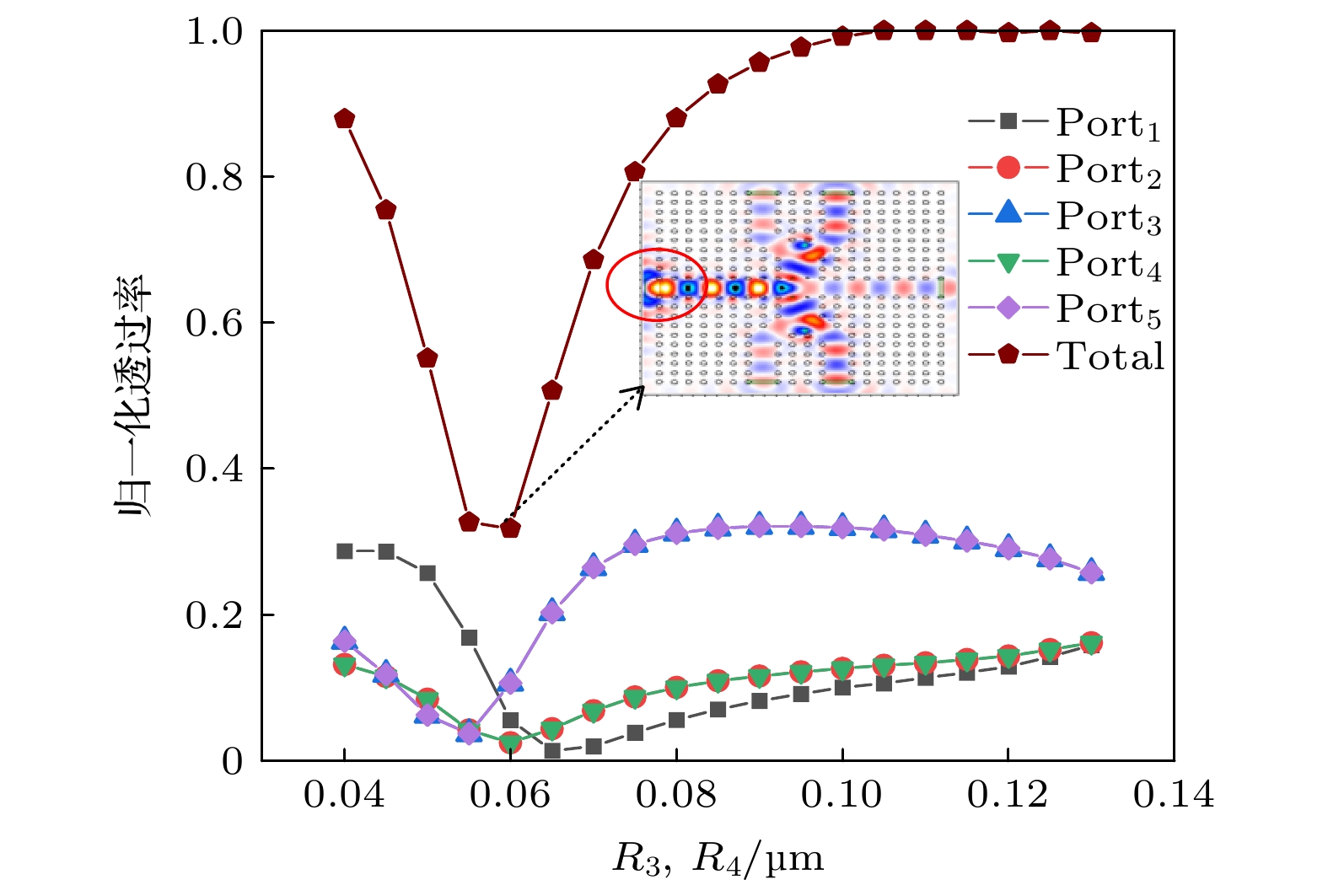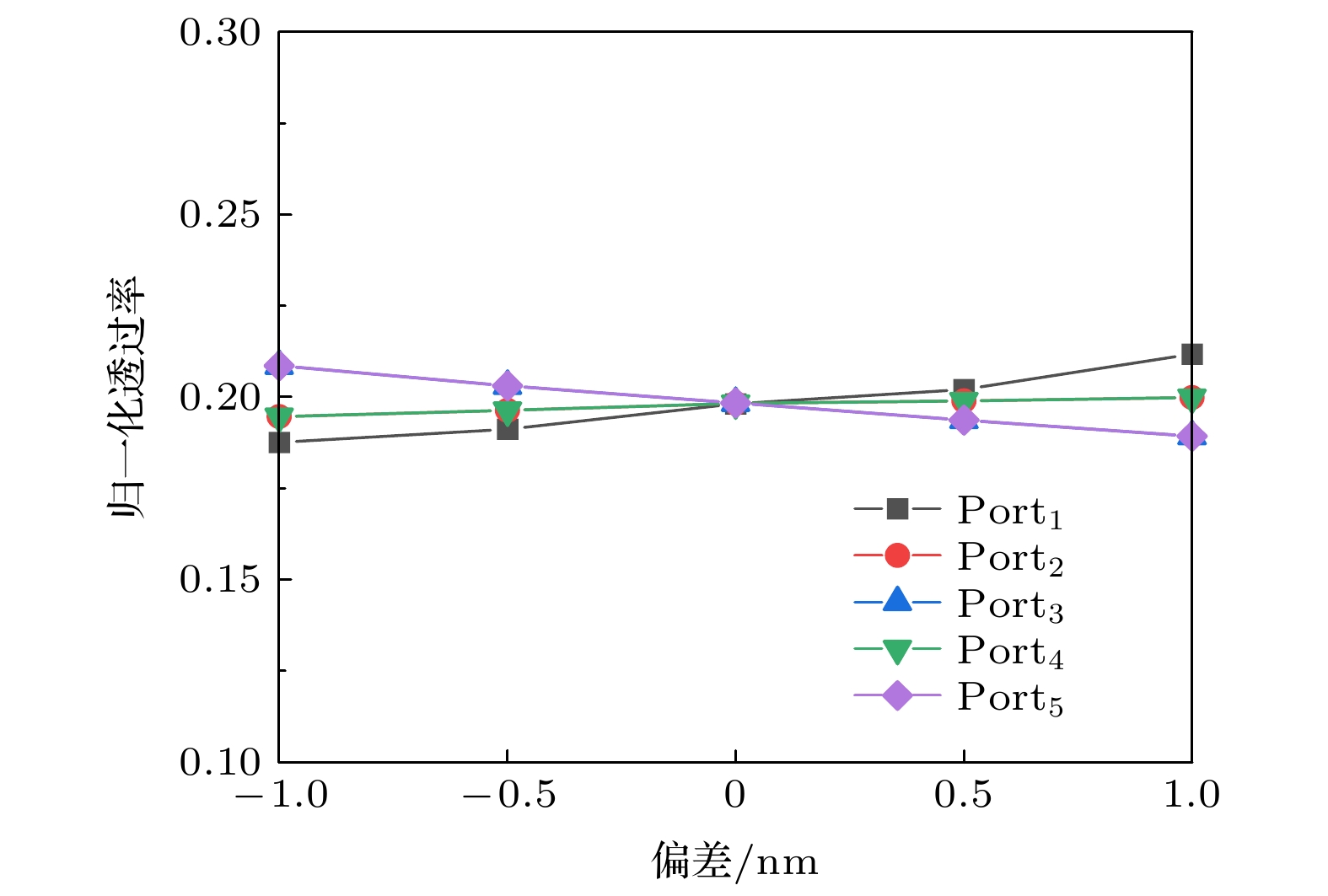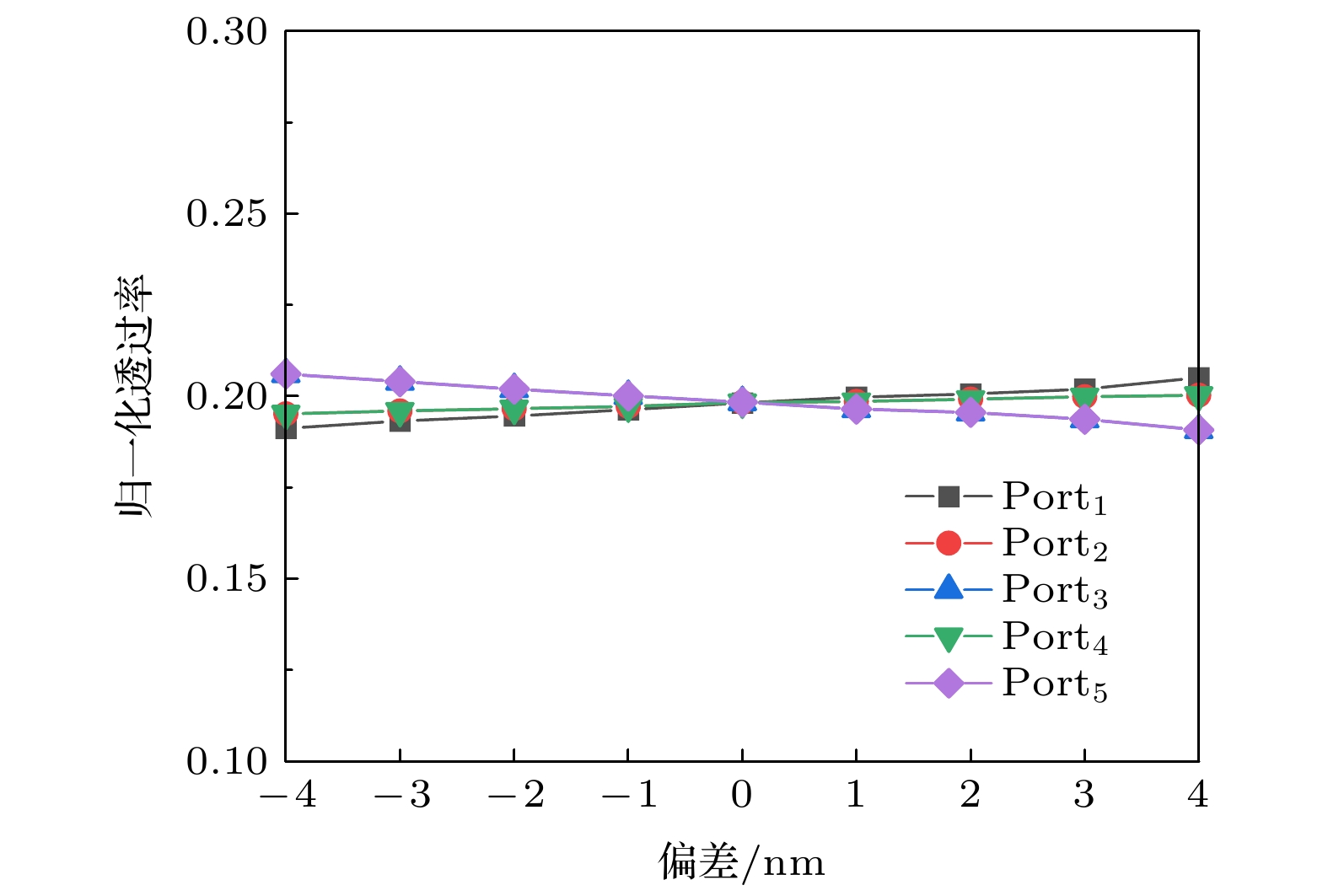-
提出了一种新颖的二维光子晶体波导型1×5分束器, 为了提高分束器的优化效率和分束性能, 利用下山单纯形算法, 对提出的1×5分束器进行逆向设计和研究. 结果表明, 改变耦合区域介质柱半径、Y分支波导中央的调控介质柱半径及其横向偏移量, 可以调节分束器5个输出端口的输出光功率比例; 利用下山单纯形算法, 根据特定的分光比目标, 对耦合区域介质柱半径、调控介质柱半径及其横向偏移量进行优化, 可以逆向设计出总透过率达到99%以上、附加损耗小于0.044 dB以及响应时间小于1 ps的不同分光比的1×5分束器. 此外, 对逆向设计的1×5分束器进行了工艺误差分析, 确定了各优化参量在实际加工中允许的误差范围, 为器件的制作提供了理论参考. 该1×5分束器分光比设计灵活, 优化效率高, 性能优良, 尺寸小, 在光子集成电路等领域中具有广泛的应用前景.Beam splitter, whose main function is to achieve the splitting, combining and routing of optical signals, is an important component of photonic integrated circuits, passive optical network and other fields. Compared with the conventional beam splitter, photonic crystal beam splitter, which has the virtues of smaller size and higher transmission efficiency, is very suitable for high-density and large-scale integration. The traditional control variable method often used in the optimal design of photonic crystal beam splitter is time-consuming and inefficient. When parameter variables are large, it is difficult for beam splitter to achieve the optimal splitting performance. In addition, it is hard to realize flexible design of beam splitting ratio when optimizing multi-channel photonic crystal beam splitter by this method. In this paper, a novel photonic crystal 1×5 beam splitter, in which two special Y-junction waveguides are introduced into a completely two-dimensional square lattice silicon, is proposed and optimally designed by using downhill-simplex algorithm. Firstly, to determine the optimization range of each variable, the influences of the radius of the dielectric rod in the coupling region and the radius and the lateral offset of the regulating dielectric rod in the center of the two Y-junction waveguides on the five output ports of the 1×5 beam splitter are explored respectively by the plane wave expansion method and finite difference time domain method. The results show that the optical energy coupled from the main waveguide W1 to the upper Y-junction waveguide and lower Y-junction waveguide can be controlled by optimizing the radius of the dielectric rod in the coupling region. The transmittance of the five output ports can be controlled in proportion by optimizing the lateral offset of the regulating dielectric rods. The total transmittance of the five output ports can be improved, and the output of each port can be adjusted by optimizing the radius of the regulating dielectric rod. Then, according to the specific target of the splitting ratio, using downhill-simplex algorithm, the 1×5 beam splitter with different splitting ratio can be reversely designed by optimizing the radius of the coupling dielectric rod and the radius and the lateral offset of the regulating dielectric rod within the selected optimization range. The total transmittance of the 1×5 beam splitter is above 99%, the additional loss is less than 0.044 dB, and the response time is less than 1ps. Besides, to determine the allowable error range of each optimization variable in actual processing, the machining error of the 1×5 beam splitter is analyzed, which provides a theoretical reference for fabricating the device. Owing to the advantages of flexible splitting ratio design, high optimization efficiency, small size and excellent performance, the proposed 1×5 beam splitter will have broad application prospects in the field of photonic integrated circuits and so on.
-
Keywords:
- beam splitter /
- reverse design /
- downhill-simplex algorithm /
- photonic crystal
[1] 于天宝 2007 博士学位论文 (杭州: 浙江大学)
Yu T B 2007 Ph. D. Dissertation (Hangzhou: Zhejiang University) (in Chinese)
[2] Tao S H, Fang Q, Song J F, Yu M B, Lo G Q, Kwong D L 2008 Opt. Express 16 21456
 Google Scholar
Google Scholar
[3] Yao R K, Li H X, Zhang B H, Chen W W, Wang P J, Dai S X, Liu Y X, Li J, Li Y, Fu Q 2021 J. Lightwave Technol. 39 6253
 Google Scholar
Google Scholar
[4] Lin Z J, Shi W 2019 Opt. Express 27 14338
 Google Scholar
Google Scholar
[5] Chen H, Zou S Z, Yu H J, Lin X C 2015 IEEE Photon. Technol. Lett. 27 2527
 Google Scholar
Google Scholar
[6] Ferstl M, Hermerschmidt A, Dias D, Steingruber R 2004 J. Mod. Opt. 51 2125
 Google Scholar
Google Scholar
[7] Tahersima M H, Kojima K, Koike A T, Jha D, Wang B N, Lin C W, Parsons K 2019 Sci. Rep. 9 1368
 Google Scholar
Google Scholar
[8] 左依凡, 李培丽, 栾开智, 王磊 2018 物理学报 67 034204
 Google Scholar
Google Scholar
Zuo Y F, Li P L, Luan K Z, Wang L 2018 Acta Phys. Sin. 67 034204
 Google Scholar
Google Scholar
[9] Hu J R, Li J S 2016 J. Infrared Millim. Te. 37 729
 Google Scholar
Google Scholar
[10] Singh S, Singh K 2017 Optik 145 495
 Google Scholar
Google Scholar
[11] Rakshitha M, Gandhi S I 2018 4th International Conference on Devices, Circuits and Systems Coimbatore, India, March 16–17, 2018 p25
[12] 刘凯柱 2020 硕士学位论文 (北京: 中央民族大学)
Liu K Z 2020 M. S. Thesis (Beijing: Minzu University of China) (in Chinese)
[13] 金轶群, 文化锋, 李韵嘉, 王周益, 胡帆, 周华英, 施锋 2021 光电子·激光 32 281
 Google Scholar
Google Scholar
Jin Y Q, Wen H F, Li Y J, Wang Z Y, Hu F, Zhou H Y, Shi F 2021 J. Optoelectronics·Laser 32 281
 Google Scholar
Google Scholar
[14] Moumeni I, Labbani A 2021 Opt. Quant. Electron. 53 129
 Google Scholar
Google Scholar
[15] Nelder J A, Mead R 1965 Comput. J. 7 308
 Google Scholar
Google Scholar
[16] Chelouah R, Siarry P 2003 Eur. J. Oper. Res. 148 335
 Google Scholar
Google Scholar
[17] Su H L, Lan F C, He Y Y, Chen J Q 2020 Eng. Computation 37 1423
 Google Scholar
Google Scholar
[18] 陈颖, 王文跃, 于娜 2014 物理学报 63 034205
 Google Scholar
Google Scholar
Chen Y, Wang W Y, Yu N 2014 Acta Phys. Sin. 63 034205
 Google Scholar
Google Scholar
[19] 厉梦瑶, 徐光跃, 郑加金, 李培丽 2021 光电子·激光 32 799
 Google Scholar
Google Scholar
Li M Y, Xu G Y, Zheng J J, Li P L 2021 J. Optoelectronics·Laser 32 799
 Google Scholar
Google Scholar
[20] 费宏明, 严帅, 徐瑜成, 林瀚, 武敏, 杨毅彪, 陈智辉, 田媛, 张娅敏 2020 物理学报 69 184214
 Google Scholar
Google Scholar
Fei H M, Yan S, Xu Y C, Lin H, Wu M, Yang Y B, Chen Z H, Tian Y, Zhang Y M 2020 Acta Phys. Sin. 69 184214
 Google Scholar
Google Scholar
[21] 郗翔, 叶康平, 伍瑞新 2020 物理学报 69 154102
 Google Scholar
Google Scholar
Xi X, Ye K P, Wu R X 2020 Acta Phys. Sin. 69 154102
 Google Scholar
Google Scholar
[22] 赵绚, 刘晨, 马会丽, 冯帅 2017 物理学报 66 114208
 Google Scholar
Google Scholar
Zhao X, Liu C, Ma H L, Feng S 2017 Acta Phys. Sin. 66 114208
 Google Scholar
Google Scholar
[23] Park H, Lee S 2020 ACS Photonics 7 1577
 Google Scholar
Google Scholar
[24] Hsieh M L, Chen S Y, Kaiser A, Yan Y J, Frey B, Bhat I, Dahal R, Bhattacharya S, John S, Lin S Y 2019 AIP Adv. 9 085206
 Google Scholar
Google Scholar
-
-
[1] 于天宝 2007 博士学位论文 (杭州: 浙江大学)
Yu T B 2007 Ph. D. Dissertation (Hangzhou: Zhejiang University) (in Chinese)
[2] Tao S H, Fang Q, Song J F, Yu M B, Lo G Q, Kwong D L 2008 Opt. Express 16 21456
 Google Scholar
Google Scholar
[3] Yao R K, Li H X, Zhang B H, Chen W W, Wang P J, Dai S X, Liu Y X, Li J, Li Y, Fu Q 2021 J. Lightwave Technol. 39 6253
 Google Scholar
Google Scholar
[4] Lin Z J, Shi W 2019 Opt. Express 27 14338
 Google Scholar
Google Scholar
[5] Chen H, Zou S Z, Yu H J, Lin X C 2015 IEEE Photon. Technol. Lett. 27 2527
 Google Scholar
Google Scholar
[6] Ferstl M, Hermerschmidt A, Dias D, Steingruber R 2004 J. Mod. Opt. 51 2125
 Google Scholar
Google Scholar
[7] Tahersima M H, Kojima K, Koike A T, Jha D, Wang B N, Lin C W, Parsons K 2019 Sci. Rep. 9 1368
 Google Scholar
Google Scholar
[8] 左依凡, 李培丽, 栾开智, 王磊 2018 物理学报 67 034204
 Google Scholar
Google Scholar
Zuo Y F, Li P L, Luan K Z, Wang L 2018 Acta Phys. Sin. 67 034204
 Google Scholar
Google Scholar
[9] Hu J R, Li J S 2016 J. Infrared Millim. Te. 37 729
 Google Scholar
Google Scholar
[10] Singh S, Singh K 2017 Optik 145 495
 Google Scholar
Google Scholar
[11] Rakshitha M, Gandhi S I 2018 4th International Conference on Devices, Circuits and Systems Coimbatore, India, March 16–17, 2018 p25
[12] 刘凯柱 2020 硕士学位论文 (北京: 中央民族大学)
Liu K Z 2020 M. S. Thesis (Beijing: Minzu University of China) (in Chinese)
[13] 金轶群, 文化锋, 李韵嘉, 王周益, 胡帆, 周华英, 施锋 2021 光电子·激光 32 281
 Google Scholar
Google Scholar
Jin Y Q, Wen H F, Li Y J, Wang Z Y, Hu F, Zhou H Y, Shi F 2021 J. Optoelectronics·Laser 32 281
 Google Scholar
Google Scholar
[14] Moumeni I, Labbani A 2021 Opt. Quant. Electron. 53 129
 Google Scholar
Google Scholar
[15] Nelder J A, Mead R 1965 Comput. J. 7 308
 Google Scholar
Google Scholar
[16] Chelouah R, Siarry P 2003 Eur. J. Oper. Res. 148 335
 Google Scholar
Google Scholar
[17] Su H L, Lan F C, He Y Y, Chen J Q 2020 Eng. Computation 37 1423
 Google Scholar
Google Scholar
[18] 陈颖, 王文跃, 于娜 2014 物理学报 63 034205
 Google Scholar
Google Scholar
Chen Y, Wang W Y, Yu N 2014 Acta Phys. Sin. 63 034205
 Google Scholar
Google Scholar
[19] 厉梦瑶, 徐光跃, 郑加金, 李培丽 2021 光电子·激光 32 799
 Google Scholar
Google Scholar
Li M Y, Xu G Y, Zheng J J, Li P L 2021 J. Optoelectronics·Laser 32 799
 Google Scholar
Google Scholar
[20] 费宏明, 严帅, 徐瑜成, 林瀚, 武敏, 杨毅彪, 陈智辉, 田媛, 张娅敏 2020 物理学报 69 184214
 Google Scholar
Google Scholar
Fei H M, Yan S, Xu Y C, Lin H, Wu M, Yang Y B, Chen Z H, Tian Y, Zhang Y M 2020 Acta Phys. Sin. 69 184214
 Google Scholar
Google Scholar
[21] 郗翔, 叶康平, 伍瑞新 2020 物理学报 69 154102
 Google Scholar
Google Scholar
Xi X, Ye K P, Wu R X 2020 Acta Phys. Sin. 69 154102
 Google Scholar
Google Scholar
[22] 赵绚, 刘晨, 马会丽, 冯帅 2017 物理学报 66 114208
 Google Scholar
Google Scholar
Zhao X, Liu C, Ma H L, Feng S 2017 Acta Phys. Sin. 66 114208
 Google Scholar
Google Scholar
[23] Park H, Lee S 2020 ACS Photonics 7 1577
 Google Scholar
Google Scholar
[24] Hsieh M L, Chen S Y, Kaiser A, Yan Y J, Frey B, Bhat I, Dahal R, Bhattacharya S, John S, Lin S Y 2019 AIP Adv. 9 085206
 Google Scholar
Google Scholar
计量
- 文章访问数: 8495
- PDF下载量: 102
- 被引次数: 0













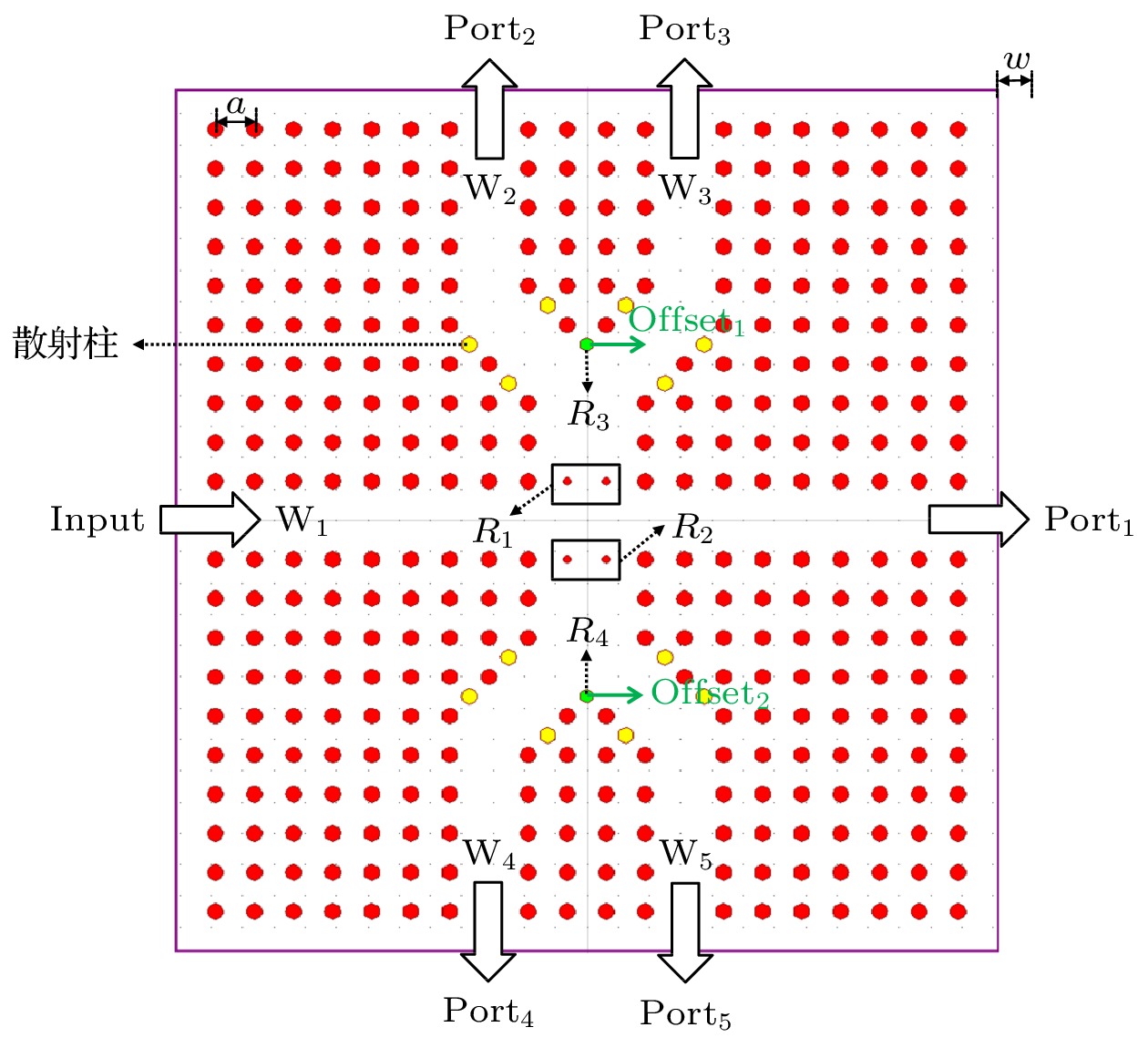
 下载:
下载:


